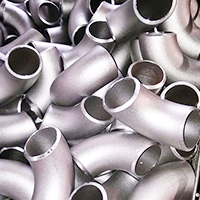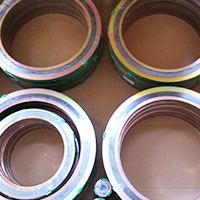①Surface Color Whitening Treatment②Surface Mirror Gloss Treatment③Surface Coloring Treatment
1.2.1 Surface color whitening treatment: Stainless steel flange in the process of processing, after winding, tying, welding or after artificial surface fire heating treatment, produce black oxide skin. This hard gray-black oxide skin is mainly composed of two EO4 components, NiCr2O4 and NiF, which were previously removed by strong corrosion methods of hydro fluoric acid and nitric acid. However, this method is costly, polluting the environment, harmful to the human body, corrosive, and gradually eliminated.
At present, there are two main methods for the treatment of oxide skin
(1)Sandblasting (pill) method: it mainly uses the method of spraying micro-glass beads to remove the black oxide skin on the surface.
(2)Chemical method: Use a pollution-free pickling passivation paste and room temperature non-toxic cleaning solution with inorganic additives for immersion. So as to achieve the purpose of whitening stainless steel flange color. After processing, it basically looks like a dull color. This method is more suitable for large and complex products.
1.2.2 Stainless steel flange surface mirror gloss treatment method: according to the complexity of stainless steel flange products and different user requirements, mechanical polishing, chemical polishing, electro chemical polishing and other methods can be used to achieve mirror gloss.
1.2.3 Surface coloring treatment: stainless steel flange coloring not only gives stainless steel flange products a variety of colors, increase the design and color of products, but also improve the wear resistance and corrosion resistance of products.
Stainless steel flange is a connecting piece on industrial pipeline, which is used to connect the pipe ends with each other. Stainless steel flange is also called flange flange disc or flange. The stainless steel flange is connected to each other by flange, gasket and bolt as a set of removable connection of the combined sealing structure.
Stainless steel flange coloring methods are as follows:
⑴ Chemical oxidation staining method;
⑵ Electrochemical oxidation staining method;
⑶ Ion deposition oxide staining method;
⑷ High temperature oxidation dyeing method;
⑸ Gas phase lysis staining method.
A brief overview of the various methods is as follows:
⑴ Chemical oxidation coloring method: it is in a specific solution. The color of the film is formed by chemical oxidation. There are dichromate method, mixed sodium salt method, sulfide method, acid oxidation method and basic oxidation method/general "INCO method" used more. But if you want to ensure that a batch of products are the same color. It must be controlled with a reference electrode.
⑵ Electro chemical staining method: it is the color of the film formed by electro chemical oxidation in a specific solution.
⑶ Ion deposition oxide coloring method chemical method: is to put the stainless steel flange work piece in the vacuum coating machine for vacuum evaporation plating. For example: titanium plated hand watch case, watch band, is generally golden yellow. This method is suitable for processing large quantities of products. Because of the large investment and high cost, small batch products are not cost-effective.
⑷ High temperature oxidation dyeing method: in a specific molten salt, the work piece is immersed in a certain process parameters, so that the work piece forms a certain thickness of the oxide film, and shows a variety of different colors.
⑸ Gas phase cracking and coloring method: more complex, less used in industry.
So surface of stainless steel flange method as above.













